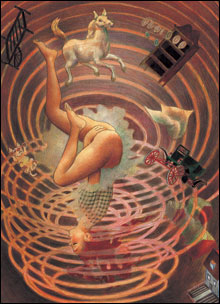
HOT STUFF: What Moore and Gebbie get about sexual fantasy is that in the heat of the moment, we can be turned on by anything.
|
There are many old conflicts being played out in the argument over whether there’s a difference between pornography and erotica: male versus female; images versus words; explicitness versus suggestion. Pornography tends to be associated with the first half of those oppositions, erotica with the second. At bottom (or top), the difference between porn and erotica, a difference I don’t believe exists, is a class argument, with proponents of the latter claiming their sexual fantasies and desires are more refined and enlightened than those of the obviously coarser orders. Their position could be summed up by this imagined distinction: “If it puts me in mind of being fed ripe grapes on a summer’s day by a lusty woodsman, it’s erotica; if it gives you a hard-on, it’s porn.”
Lost Girls, the new slipcased three-volume work by writer Allan Moore (Watchmen, V for Vendetta, From Hell) and illustrator Melinda Gebbie, is out to destroy those distinctions. Being a graphic novel, it gives equal weight to images and words. Being a collaboration between a man and a woman, it takes sexual fantasies beyond the provenance of any one sex or orientation. Most of all, being both elegant and explicit, refined and raunchy, it aims to obliterate the idea that there’s a difference between pornography and erotica. Lost Girls is proudly self-proclaimed porn that wants to appeal to our imaginations as well as our bodies. Moore and Gebbie want to leave their readers wet, hard, and dreaming.
The tale is set in an Austrian hotel shortly before the outset of World War I, a place that calls up the kind of European elegance, luxurious and dying, that you find in the fiction of Arthur Schnitzler or Stefan Zweig. A clue to what lies ahead is the volume that the rotund and worldly owner, Monsieur Rougeur, has placed on the night stand of each room. M. Rougeur’s “White Book” is a compendium of erotic stories that he claims the likes of Apollinaire and Oscar Wilde have written and that are illustrated by the likes of Alphonse Mucha, Aubrey Beardsley, and Egon Schiele, or by some extremely talented forgers. It’s the establishment’s Gideon Bible, and it’s a fitting symbol for Lost Girls, whose authors have fashioned themselves as evangelists of the erotic.
And also, you might say, as cultural archivists. The three principals of Lost Girls are the wealthy Alice, an aging but still sexually active lesbian returned to Europe from South Africa, where her family had sent her to oversee their diamond mine and so rid themselves of the scandal she’d brought upon them; Dorothy, a rich and horny young American; and Wendy, the reserved bourgeois English wife of a stuffy older man, an engineer who’s ignorant of his wife’s desires and women’s desires in general. These three are also the heroines of the most famous works by, respectively, Lewis Carroll, L. Frank Baum, and James M. Barrie. Making one another’s social, and then sexual, acquaintance, they spin out the tales of their individual sexual awakenings. In other words, how each one ventured through the looking glass, onto the yellow brick road, into Neverland.
What Moore has done here is a version of what he does in his ongoing series The League of Extraordinary Gentlemen, in which the likes of Dr. Jekyll, Captain Nemo, Mina Harker, Allan Quartermain, and Griffin, the scientist from The Invisible Man, form a Victorian crimefighting team. Just as the League series is an alternate history of some of the most famous characters from imaginative literature, Lost Girls nudges the plots of Carroll, Baum, and Barrie so that they become sexual metaphors. Dorothy’s first orgasm is illustrated by a panel of her with her fingers between her legs falling head first into a tornado high above her Kansas farmhouse while Toto and a Model-T swirl nearby — sex turns her world upside down. Peter Pan is a teenage hustler whom Wendy and her brothers encounter in the park; Captain Hook is the friend of her father’s who molests her. The Red Queen is Alice’s boarding-school teacher, whom she goes to work for and who initiates her into increasingly cruel and degrading sexual encounters.
The hotel is the secluded utopia that is one of the conventions of porn (like the château in The Story of O). The three women confess these histories to one another and use them to spur on the erotic encounters among them. And that’s not the only sex going on here — both Dorothy and Wendy’s husband dally with an Austrian captain. M. Rougeur invites the women to join a hotel-wide orgy after the less “liberal” guests have fled following the outbreak of war. And the fantasies themselves — gay, straight, bisexual — incorporate group sex, masturbation, S&M, fetishism, incest, pedophilia, and bestiality. Lost Girls is, if nothing else, egalitarian smut. The lesbian scenes could be male or female fantasies; same with the gay scenes, in which the men often switch between women and men. What the authors get about sexual fantasy is that in the heat of the moment, we can be turned on by anything. And their blending of the elegant with the really, really dirty is an admirable achievement that pays porn the respect of believing it’s worth doing well. But as attractive an object as Lost Girls is, it also reminds you that, in porn, æsthetic standards are beside the point. Just as a movie or book doesn’t have to be good to be effective, neither does porn. That doesn’t mean we shouldn’t hope for better pornographers.